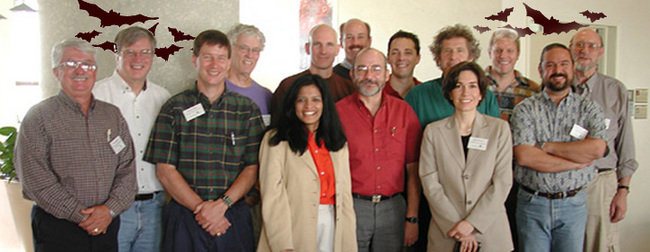NCEAS Working Groups
An ecological-economic analysis of pest-control services: The Brazilian Free-tailed Bat as a model
Project Description
Ecosystem services underpin human existence, yet we know little about the magnitude of these services in terms of what policy makers need to incorporate into decision-making frameworks. The objective of this project is to analyze existing databases for developing an ecological-economic model of pest-control services provided by an important insectivorous bat (Tadarida brasiliensis). Computer algorithms will be developed for estimating numbers of bats based on infrared thermal imaging, and population models of pest species will be developed based on available life-history data. Dynamic modeling and GIS will be used to integrate extant databases on bat foraging from Dopper radar (NEXRAD) data, crop and insect phenology, seasonal migration of bats and insects, and agricultural crop distribution, yield, and inputs. Ultimately, models will include sensitivity analysis to estimate the monetary value of the pest-control service, and thus provide the first comprehensive analysis of a major vertebrate predator of importance to agroecosystem productivity in North America.

Principal Investigator(s)
Thomas H. Kunz
Project Dates
Start: May 1, 2002
End: January 31, 2004
completed
Participants
- Margrit Betke
- Boston University
- Donald R. Clark
- Department of Wildlife and Fisheries Sciences
- Cutler Cleveland
- Boston University
- Adriana Nelly Correa Sandoval
- Tecnológico de Monterrey (ITESM Monterey)
- Stephen Crampton
- Boston University
- Paula Federico
- University of Tennessee
- Jeff D. Frank
- Indigo Systems Corporation
- Irma A. Gomez
- Tecnológico de Monterrey (ITESM Monterey)
- Sucharita Gopal
- Boston University
- William E. Grant
- Texas A and M University
- Thomas G. Hallam
- University of Tennessee, Knoxville
- Jason Horn
- Boston University
- Thomas H. Kunz
- Boston University
- Juan Lopez
- United States Department of Agriculture
- Gary F. McCracken
- University of Tennessee
- Rodrigo A. Medellin
- Instituto de Ecología, UNAM
- Arnulfo Moreno-Valdez
- Instituto Tecnológico de Cd. Victoria
- Chris Sansone
- Texas A and M University
- Richard D. Stevens
- University of California, Santa Barbara
- John Westbrook
- United States Department of Agriculture
Products
-
Presentations / 2004
Build it and they will come: Establishment of a founder colony of Brazilian free-tailed bats (Tadarida brasiliensis) in a man-made cave
-
Presentations / 2004
Censusing Brazilian free-tailed bats with infrared thermal imaging: Challenges, lessons learned, and initial results
-
Software /
Graphical computer interface and automated oject recognition and tracking algorithms
-
Presentations / 2004
Economic value of pest control services by Brazilian free-tailed bats in Texas cotton production
-
Journal Article / 2006
Economic value of the pest control service provided by Brazilian free-tailed bats in south-central Texas
-
Presentations / 2004
Modeling the agricultural pest control service provided by Brazilian Free-tailed Bats (Tadarida brasiliensis) in the Winter Garden region of south Texas
-
Presentations / 2002
Physiologically based models of bat dynamics
-
Presentations / 2003
The AGROBAT project: Modeling and analysis
-
Presentations / 2003
The AGROBAT project: Modeling and analysis
-
Presentations / 2003
The AGROBAT project: Models
-
Presentations / 2004
Community and individual responses of Brazilian free-tailed bats (Tadarida brasiliensis) to avian predation
-
Presentations / 2003
Censusing Brazilian free-tailed bats using infrared thermal imaging and computer vision methods. Abstract. Awarded
-
Presentations / 2004
Computer vision for tracking bats in infrared thermal video: A tool for understanding the behavior of bats in flight (poster)
-
Presentations / 2002
Behavioral dynamics of large-scale nightly emergences and dispersal of Brazilian free-tailed bats (tadarida brasiliensis)
-
Presentations / 2001
Ecological, behavioral, and physiological applications of infrared thermal imaging for the study of bats. Abstract
-
Presentations / 2002
Reproductive energetics of free-ranging Brazilian free-tailed bats: value added knowledge for assessing ecosystem services
-
Book Chapter / 2003
Censusing bats: Challenges, solutions, and sampling biases
-
Report or White Paper / 2003
Methods for estimating numbers of bats: Challenges, problems, and sampling biases
-
Presentations / 2003
Reproductive energetics of free-ranging Brazilian free-tailed bats: value added knowledge for assessing ecosystem services, 5 May 2003
-
Book Chapter / 2004
Foraging habits of North American bats
-
Presentations / 2004
Reproductive energetics of free-ranging Brazilian free-tailed bats: value added knowledge for assessing ecosystem services, 16 January 2004
-
Presentations / 2004
Reproductive energetics of free-ranging Brazilian free-tailed bats: value added knowledge for assessing ecosystem services, 19 January 2004
-
Presentations / 2004
Bats in motion: Stereo object recognition and trajectory: Analysis of flying bats (poster)
-
Journal Article / 2002
Foraging activity and food resource use of Brazilian free-tailed bats, Tadarida brasiliensis (Molossidae)
-
Journal Article / 2005
Dietary variation of Brazilian free-tailed bats links to migratory populations of pest insects
-
Book Chapter / 2003
Estimates of population sizes in summer colonies in Brazilian free-tailed bats (Tadarida brasiliensis)
-
Presentations / 2004
Bats, guano, and ecosystems (award-winning poster)
-
Presentations / 2002
Bats and panmixis: Investigating population genetic structure in large populations of migratory bats. Recipient of Best Student Paper Award
